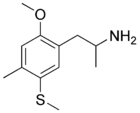.gif)
TOM (psychedelic)
Encyclopedia
| TOM | |
|---|---|
| Chemical name IUPAC nomenclature A chemical nomenclature is a set of rules to generate systematic names for chemical compounds. The nomenclature used most frequently worldwide is the one created and developed by the International Union of Pure and Applied Chemistry .... |
Thio Thio The prefix thio-, when applied to a chemical, such as an ion, means that an oxygen atom in the compound has been replaced by a sulfur atom. This meaning is especially valid in organic chemistry. For example, the word ether refers to an oxygen-containing compound having the general chemical... mescaline Mescaline Mescaline or 3,4,5-trimethoxyphenethylamine is a naturally occurring psychedelic alkaloid of the phenethylamine class used mainly as an entheogen.... |
| Chemical formula Chemical formula A chemical formula or molecular formula is a way of expressing information about the atoms that constitute a particular chemical compound.... |
C12H19NOS |
 |
|
TOM, or methylthio
Thio
The prefix thio-, when applied to a chemical, such as an ion, means that an oxygen atom in the compound has been replaced by a sulfur atom. This meaning is especially valid in organic chemistry. For example, the word ether refers to an oxygen-containing compound having the general chemical...
-methyl-methoxy
Methoxy
In chemistry , methoxy refers to the functional group consisting of a methyl group bound to oxygen. This alkoxy group has the formula O–CH3.The word is used in organic nomenclature usually to describe an ether...
amphetamine
Amphetamine
Amphetamine or amfetamine is a psychostimulant drug of the phenethylamine class which produces increased wakefulness and focus in association with decreased fatigue and appetite.Brand names of medications that contain, or metabolize into, amphetamine include Adderall, Dexedrine, Dextrostat,...
, is a series of lesser-known psychedelic drugs
Psychedelics, dissociatives and deliriants
This general group of pharmacological agents can be divided into three broad categories: psychedelics, dissociatives, and deliriants. These classes of psychoactive drugs have in common that they can cause subjective changes in perception, thought, emotion and consciousness...
and substituted amphetamines. 2-TOM and 5-TOM are the 2 and 5 methylthio analogs of DOM/STP
DOM
DOM may refer to:*D.O.M. , a restaurant in São Paulo, Brazil*Days on market, how many days since a piece of real estate was listed for sale*Deo optimo maximo, Latin for "to the Greatest and Best God", originally Jove, later the Christian God...
, respectively. They were first synthesized by Alexander Shulgin
Alexander Shulgin
Alexander "Sasha" Theodore Shulgin is an American pharmacologist, chemist, artist, and drug developer.Shulgin is credited with the popularization of MDMA, commonly known as ecstasy, in the late 1970s and early 1980s, especially for psychopharmaceutical use and the treatment of depression and...
and written up in his book PiHKAL (Phenethylamines i Have Known And Loved)
PiHKAL
PiHKAL: A Chemical Love Story is a book by Dr. Alexander Shulgin and Ann Shulgin which was published in 1991. The subject of the work is psychoactive phenethylamine chemical derivatives, notably those that act as psychedelics and/or empathogen-entactogens...
. Very little data is known about their dangers or toxicity.
TOM compounds


2-TOM
Dosage: 60–100 mgDuration: 8–10 hours
Effects: strong closed-eye visuals upon listening to music, ++ on the Shulgin Rating Scale
Shulgin Rating Scale
The Shulgin Rating Scale is a simple scale for reporting the subjective effect of psychoactive substances at a given dosage, and at a given time...
5-TOM
Dosage: 30–50 mgDuration: 6–10 hours
Effects: open and closed-eye visuals, psychedelia, hallucinations
See also
- PhenethylaminePhenethylaminePhenylethylamine or phenethylamine is a natural monoamine alkaloid, trace amine, and also the name of a class of chemicals with many members well known for psychoactive drug and stimulant effects. Studies suggest that phenylethylamine functions as a neuromodulator or neurotransmitter in the...
- Psychedelics, dissociatives and deliriantsPsychedelics, dissociatives and deliriantsThis general group of pharmacological agents can be divided into three broad categories: psychedelics, dissociatives, and deliriants. These classes of psychoactive drugs have in common that they can cause subjective changes in perception, thought, emotion and consciousness...
- PiHKALPiHKALPiHKAL: A Chemical Love Story is a book by Dr. Alexander Shulgin and Ann Shulgin which was published in 1991. The subject of the work is psychoactive phenethylamine chemical derivatives, notably those that act as psychedelics and/or empathogen-entactogens...
- DOMDOMDOM may refer to:*D.O.M. , a restaurant in São Paulo, Brazil*Days on market, how many days since a piece of real estate was listed for sale*Deo optimo maximo, Latin for "to the Greatest and Best God", originally Jove, later the Christian God...

